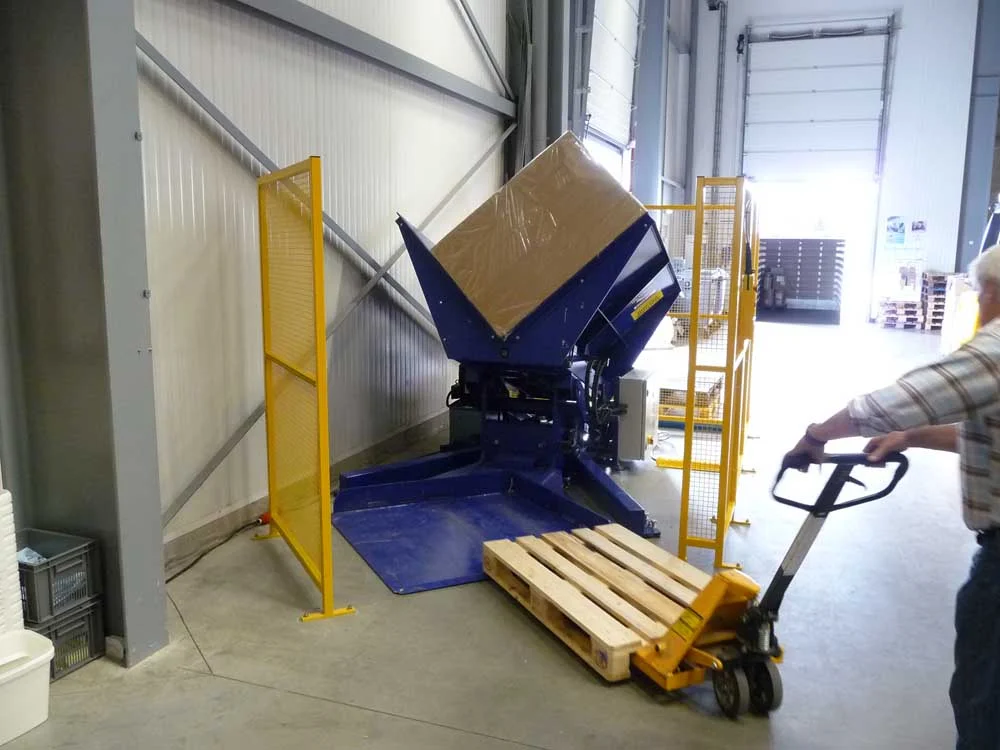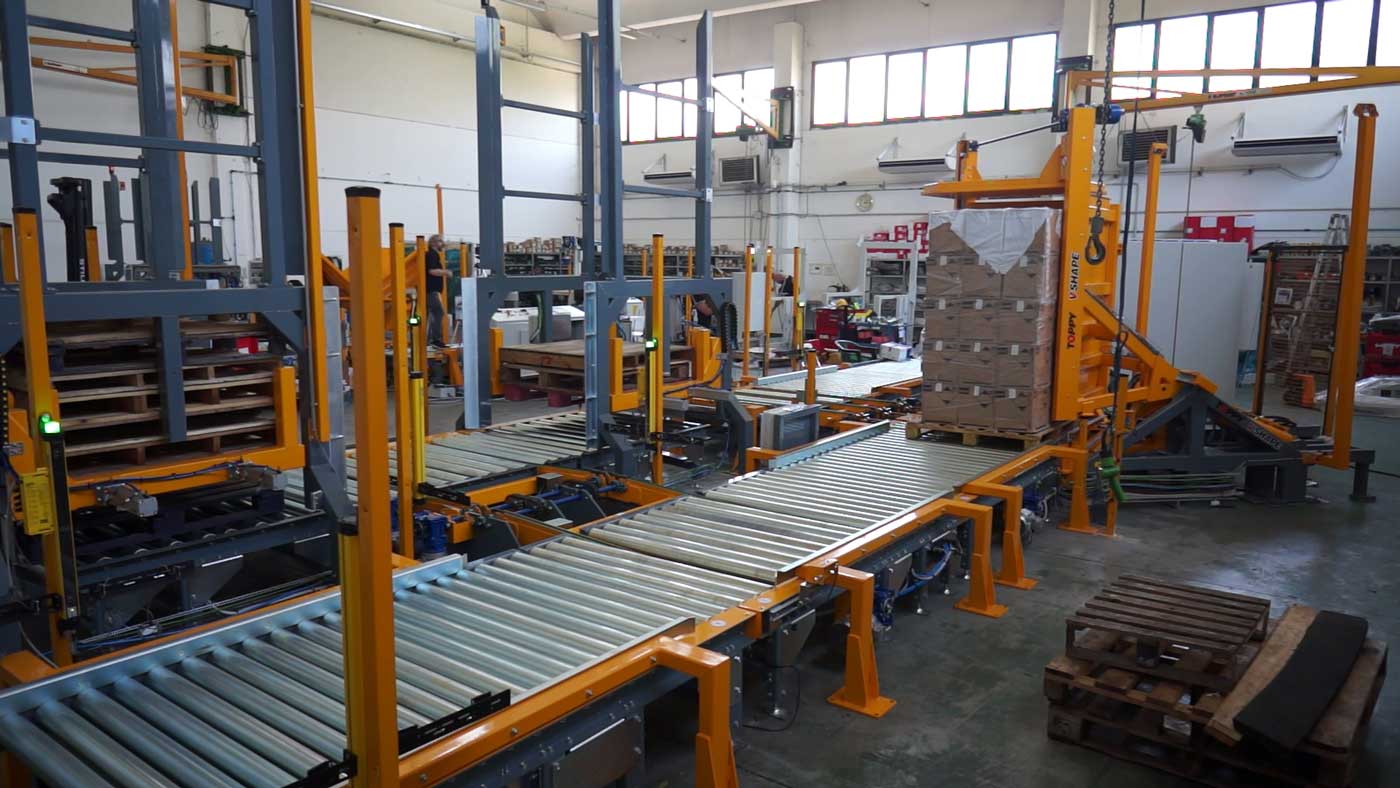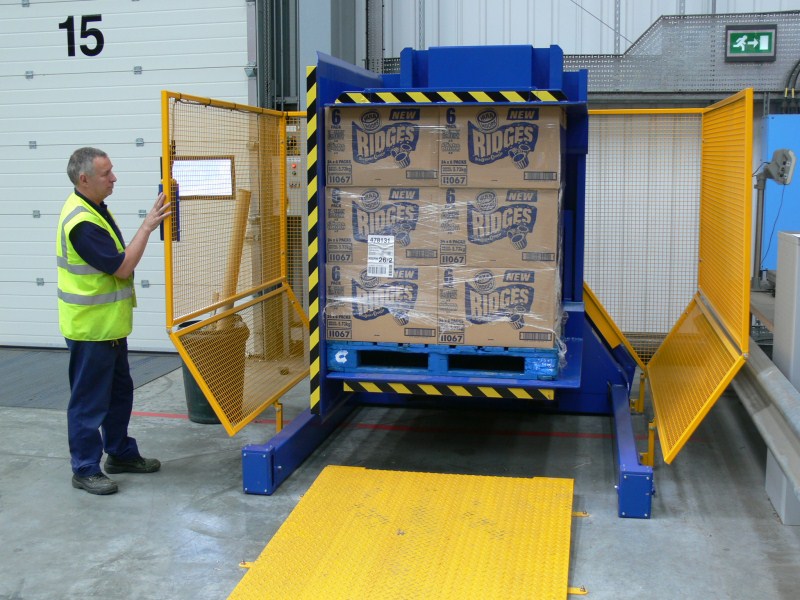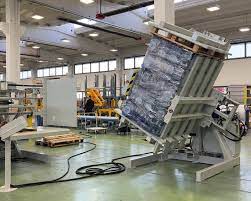Pallet Inverter: What’s the Best Method for Rotating Sticky Rubber Pallets?
Handling sticky rubber pallets is a unique challenge. You have a valuable product that needs to be flipped, maybe to switch from a house pallet to a shipping pallet, but its very nature works against you. The rubber sheets stick to each other and to the pallet. This makes a simple task slow and risky. You might be damaging products, or worse, putting your team in danger with manual handling. This can lead to production bottlenecks and financial losses, problems no plant manager wants. It's a frustrating situation where a standard solution just won't work.
The best method for rotating sticky rubber pallets is using a specialized pallet inverter. This machine should have adjustable clamping pressure, non-stick contact surfaces, and a controlled rotation speed. These features work together to gently secure the load, prevent the rubber from sticking to the machine, and turn the entire pallet without distorting or damaging the product. This approach is far superior to manual methods or standard inverters.

I have seen this exact problem many times in my career. A client thinks they have a simple pallet-switching problem, but they actually have a complex material-handling problem. The solution isn't just about turning something over; it's about understanding the specific properties of the material. In this article, we will look into why sticky rubber is so difficult to handle and explore the specific features that make a pallet inverter effective. We will also analyze the real-world benefits in terms of safety, efficiency, and return on investment.
Why Do Standard Pallet Inverters Struggle with Sticky Rubber?
You bought a standard pallet inverter to improve your workflow, but when you try to use it on your sticky rubber products, it creates more problems than it solves. The machine either crushes the load, or the rubber sticks firmly to the metal clamping plates. This causes delays, damages your valuable product, and leaves your team frustrated. You invested in a machine to save time and money, but it's costing you both. It's a common issue that stems from a fundamental mismatch between the machine's design and the material's properties.
A standard pallet inverter fails with sticky rubber because it is not designed for materials with high adhesion. These machines typically use high, uniform clamping pressure and have simple steel surfaces. This combination is fine for rigid boxes but disastrous for soft, tacky rubber. The pressure can deform the rubber sheets, while the steel plates create a strong bond with the sticky surface, leading to tearing and product loss during rotation.

The Problem of Adhesion and Pressure
The core issue is the rubber's natural stickiness, or tack. Uncured or certain types of cured rubber have a high coefficient of friction and surface adhesion. When a standard pallet inverter applies pressure, it increases the surface area contact between the rubber sheets and between the rubber and the machine's clamping plates. This is simple physics. More pressure equals more stick. A standard machine applies a single, powerful clamping force designed to hold a solid, stable load like a pallet of canned goods. It does not have the sensitivity to handle a soft, pliable material like rubber. The result is that the rubber sheets can fuse together or stick so strongly to the machine that they tear when the load is released. I remember a client in the tire industry who faced this. Their standard inverter was essentially creating a single, solid block of rubber that was impossible to separate without significant damage.
Material and Design Mismatches
Standard pallet inverters are built for durability and strength, not finesse. Their clamping plates are typically made of painted or powder-coated steel. While strong, these surfaces are not ideal for contact with sticky materials. Rubber will adhere to steel, especially under pressure. The problem gets worse over time as small bits of rubber transfer to the plates, making them even stickier for the next cycle. Furthermore, the rotation mechanism is often designed for speed, not gentle handling. The quick start and stop of a standard rotation can cause the semi-liquid nature of the rubber stack to shift and deform. The layers can slide against each other, creating shear forces that lead to internal tears or a distorted final stack.
Comparing Standard vs. Specialized Inverters
To make it clearer, let's look at a direct comparison. This table shows where standard machines fall short and how specialized machines are designed to succeed. This kind of analysis is critical before any major equipment purchase.
| Feature | Standard Pallet Inverter | Specialized Rubber Pallet Inverter | Impact on Sticky Rubber |
|---|---|---|---|
| Clamping Pressure | High, fixed pressure | Adjustable, variable pressure | Prevents crushing and product deformation. |
| Contact Surfaces | Painted or plain steel | Non-stick (Teflon, UHMW) coating | Eliminates product sticking to the machine. |
| Rotation Control | Fast, single speed | Variable speed, soft start/stop | Prevents load shifting and internal shearing. |
| Load Support | Top clamp only | Top and side clamping options | Provides stability for non-rigid loads. |
Understanding these fundamental differences is the first step. It shows that you don't just need an inverter; you need the right inverter.
What Features Should a Pallet Inverter for Rubber Have?
You know that a standard machine is not the answer. So, what should you look for? The market is filled with options, and every salesperson will tell you their machine is the best. Making the wrong choice is a costly mistake, both in terms of capital and lost production time. As a business owner, you need to be sure your investment will solve the problem effectively. The good news is that you can cut through the noise by focusing on a few essential features designed specifically for handling sticky and unconventional loads.
A pallet inverter designed for sticky rubber must have three core features: finely adjustable clamping pressure, non-stick contact surfaces, and variable speed control for rotation. These elements are non-negotiable. They provide the gentle, controlled handling necessary to rotate a sticky, pliable load without causing damage or creating operational bottlenecks. Anything less is a compromise that will likely fail.

Precision Matters: Adjustable Clamping
The ability to control clamping pressure is the most critical feature. Unlike a pallet of bricks, a pallet of rubber sheets requires a "just right" approach. Too much pressure will squeeze and deform the rubber. Too little pressure, and the load could shift during rotation, which is a major safety hazard. A quality pallet inverter for rubber uses a hydraulic system with a pressure gauge and an adjustable relief valve. This allows the operator to dial in the exact pressure needed for a specific load. For example, a heavy pallet of dense rubber might require 1200 PSI, while a lighter, softer batch may only need 800 PSI. This level of control ensures the load is secure but not crushed. It turns the machine from a blunt instrument into a precision tool. This feature alone can drastically reduce product damage, directly impacting your bottom line.
Surfaces that Don't Stick
The second key feature is the material used on the clamping plates. As we discussed, rubber sticks to steel. To solve this, specialized inverters use non-stick surfaces. The most common and effective materials are Ultra-High-Molecular-Weight (UHMW) polyethylene or a Teflon coating. UHMW is a type of plastic that is incredibly durable and has a very low coefficient of friction, almost like ice. Rubber simply does not stick to it. Applying large UHMW panels to the clamping plates and the load-bearing surfaces creates a barrier that prevents adhesion. Teflon coating works in a similar way, providing a slick surface. Some advanced models might even incorporate rollers on the bed of the inverter, which further reduces friction as the load is positioned. When I was designing solutions for a chemical company, we tested different surfaces. The difference was night and day. With steel plates, we lost 10% of the product. With UHMW plates, the loss dropped to nearly zero.
The Need for Gentle Movement
Finally, the rotation itself must be controlled. A standard inverter might rotate 180 degrees in 15 seconds. For a solid load, this is fine. For a stack of sticky rubber, this rapid movement can cause layers to shear and slide. A specialized machine should have variable speed control. This is often managed through a variable frequency drive (VFD) on the motor. The operator can program a "soft start" and "soft stop," which means the rotation accelerates and decelerates smoothly. This gentle motion keeps the entire stack moving as a single unit, preserving its integrity. It prevents the kind of shifting and distortion that ruins the product. It’s the difference between shaking a bottle of water and gently turning it over. Both result in an inverted bottle, but the contents are in very different states.
How Does a Specialized Rubber Pallet Inverter Improve Safety and Efficiency?
You're looking at the features of a specialized machine, but the real question is, "What will this do for my factory?" An investment has to deliver tangible results, especially in a competitive industry. You might be struggling with high labor costs from manual handling or production bottlenecks caused by an inefficient process. These issues directly impact your plant's overall performance. A specialized pallet inverter is not just a piece of equipment; it is a strategic tool that directly tackles these core challenges by boosting both safety and operational efficiency.
A specialized pallet inverter for rubber makes the workplace safer by completely removing the need for dangerous manual handling. It boosts efficiency by automating a slow task, dramatically reducing cycle times, and minimizing product damage to almost zero. This combination leads to higher throughput and a more streamlined, reliable production line.

A Major Step Up in Workplace Safety
Let's first consider the safety aspect, which should always be a priority. The old method of handling sticky rubber pallets is often manual. This involves two or more workers physically lifting, pulling, and flipping heavy, awkward rubber sheets. This process is a recipe for back injuries, strains, and other musculoskeletal disorders. The financial cost of a single workplace injury, including medical bills, compensation, and lost productivity, can be huge. A pallet inverter automates this entire process. A forklift operator places the pallet into the machine, pushes a button, and the machine does all the heavy work. The risk of injury from manual handling is completely eliminated for this task. This not only protects your employees but also reduces your exposure to liability and potential insurance premium increases. In my own factory, prioritizing safety through automation wasn't just good for morale; it was good for business. A safe plant is an efficient plant.
Measuring the Gains in Efficiency
Now, let's talk about efficiency, a metric that every CEO like Javier watches closely. Manual pallet turning is incredibly slow. It can take a team of workers 10-15 minutes to manually unstack and restack a single pallet of sticky rubber, and a significant portion might be damaged in the process. A pallet inverter can perform the same task in about 90 seconds, with one operator. Let's imagine you need to process 30 pallets per shift. Manually, this would take up to 7.5 hours of labor and create a massive bottleneck. With an inverter, it takes just 45 minutes of one operator's time. This frees up your workforce to focus on more value-added tasks. Furthermore, because the specialized inverter prevents product damage, your yield increases. If you were losing 5% of your product to damage and that drops to less than 1%, the savings go straight to your profit margin.
The Before-and-After Impact
This table clearly illustrates the transformation. It is this kind of data that justifies an investment.
| Metric | Before (Manual Handling) | After (Specialized Inverter) | Improvement |
|---|---|---|---|
| Time per Pallet | 10-15 minutes | 1.5-2 minutes | ~85% Reduction |
| Labor Required | 2-3 Workers | 1 Forklift Operator | 50-67% Labor Reduction |
| Product Damage Rate | 5-10% | <1% | ~90% Reduction in Waste |
| Injury Risk | High (Back, Strain) | Very Low | Drastic Safety Improvement |
| Process Consistency | Low | High | Predictable Throughput |
This isn't just about doing the same job faster. It's about changing the nature of the job to be safer, more reliable, and more profitable. It turns a production weak point into a streamlined part of your operation.
What's the ROI on a Specialized Pallet Inverter for Sticky Rubber?
You see the technical and operational benefits, but the final decision always comes down to the numbers. As a business owner, you have to be able to justify every major purchase with a clear financial return. A new machine can seem like a big expense, but the true cost lies in not investing. The ongoing costs of inefficiency, product waste, and potential safety incidents can be far greater than the price of the right solution. The key is to look at the investment not as a cost, but as a way to generate savings.
The return on investment (ROI) for a specialized rubber pallet inverter is typically very strong, with a payback period often between 12 and 24 months. This is achieved by calculating the total annual savings from reduced labor, eliminated product damage, and increased throughput, and comparing that figure to the initial capital cost of the machine. The financial case is usually very compelling.

Calculating Your Cost Savings
Let's break down the return on investment into clear, calculable parts. A proper analysis, which I always perform with my clients, looks at three main areas of savings.
First, labor savings. Let’s say manual handling requires two workers for 15 minutes (0.25 hours) per pallet. With a wage of $20/hour per worker, the labor cost is $10 per pallet. If an inverter reduces this to one operator for 2 minutes, the cost is about $0.67. That's a saving of over $9 per pallet. If you process 30 pallets a day, that's $270 in daily savings, or over $67,000 a year on a single shift.
Second, material savings. This is even more significant. If a pallet of your rubber product is worth $2,000 and you have a 5% damage rate with manual handling, you are losing $100 of product per pallet. By reducing that damage to less than 1% with a specialized inverter, you save at least $80 per pallet. For 30 pallets a day, that's $2,400 in daily savings. Annually, this could amount to over $600,000.
Third, increased throughput. While harder to quantify, this is a real benefit. By removing a bottleneck, you can potentially increase your entire plant's output. If the palletizing area was limiting your production, solving that problem allows you to ship more products, generating more revenue.
A Sample ROI Model
Here is a simplified model. You can plug in your own numbers to see the potential.
| Financial Metric | Example Value | Calculation | Result |
|---|---|---|---|
| A. Machine Investment Cost | $45,000 | - | $45,000 |
| B. Annual Labor Savings | $67,500 | ($9 savings/pallet) x (30 pallets/day) x (250 days) | $67,500 |
| C. Annual Material Savings | $600,000 | ($80 savings/pallet) x (30 pallets/day) x (250 days) | $600,000 |
| D. Total Annual Savings | - | B + C | $667,500 |
| Payback Period (Months) | - | (A / D) x 12 | < 1 Month |
Even with much more conservative numbers—say, only $10 of material saved per pallet—the annual savings would still be over $140,000, leading to a payback period of under 4 months. The financial argument is incredibly powerful. It shows that the machine pays for itself very quickly and then continues to contribute directly to your profit margin year after year. This is the kind of smart investment that forward-thinking leaders make to strengthen their operations.
My Insights
When I talk to business owners like Javier, I often see a common thread. They are practical, experienced leaders who have built their success from the ground up. They understand their industry inside and out. But sometimes, being so close to the daily operations can make it hard to see a problem from a new perspective. They see a pallet that needs to be flipped. I see a material handling challenge with specific properties that require an engineered solution. This is where a true partner, not just a supplier, makes a difference.
I started my journey on the factory floor. I learned firsthand how a small, persistent problem can ripple through an entire production line, causing delays and costing money. When I founded my own factory, I carried that lesson with me. Every piece of equipment I invested in had to solve a specific problem and provide a clear return. It wasn't about buying the cheapest machine; it was about buying the smartest solution.
The issue with sticky rubber pallets is a perfect example of this philosophy. Trying to solve it with a standard machine or with manual labor is a temporary patch. It doesn't address the root cause. A specialized pallet inverter, with its adjustable pressure and non-stick surfaces, is the engineered solution. It acknowledges the unique properties of the material and is designed to handle them.
Investing in this type of specialized equipment is what separates good companies from great ones. It shows a commitment to efficiency, safety, and quality. It's a strategic move that pays for itself many times over, not just in calculated ROI, but in smoother operations, higher employee morale, and a stronger, more resilient business. This is the kind of decision that helps a company grow and allows leaders like you to focus on the next big challenge, knowing your operations are running on a solid foundation.
Conclusion
A specialized pallet inverter is the definitive method for rotating sticky rubber. It addresses the core challenges of adhesion and product sensitivity, boosting safety, efficiency, and providing a rapid ROI.



